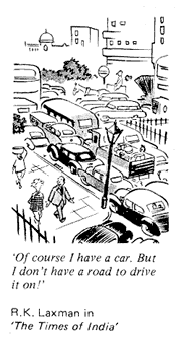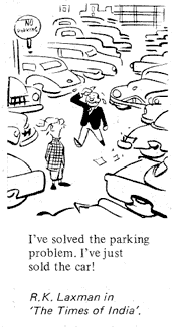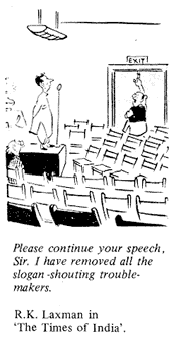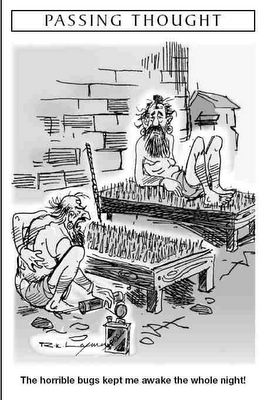Tuesday, September 27, 2005
Monday, September 26, 2005
Governance by Arun Shourie
Governance and the Sclerosis That Has Set In, by Arun Shourie
(Kindle Edition , Rupa book page, Flipkart.com)
, Rupa book page, Flipkart.com)
I wanted to briefly mention Arun Shourie's previous book, 'Governance', that was published last year. This book is not as long as some of his earlier works, but follows the pattern of his previous work, 'Courts and Their Judgments'. The chapters, the initial ones at least, are episodic, and each one serves to illustrate a particular idiosyncrasy of Indian bureaucracy or the consequences of some age-old policy being followed to its absurd conclusion.
There are many reviews available on the net of the book, and while almost all of them are very positive, the criticisms fall into two categories: those who complain that the book gets a bit tedious because of the never ending examples of lethargy, incompetence, and buck-passing in government, and those who complain because they cannot rid themselves of their prejudices against Shourie (because he was a minister in the NDA government and because they see him as belonging to the 'Hindutva' brigade)
Some of the reviews are listed below:
© 2005, Abhinav Agarwal. All rights reserved. Reposted to this blog 2011.
(Kindle Edition
I wanted to briefly mention Arun Shourie's previous book, 'Governance', that was published last year. This book is not as long as some of his earlier works, but follows the pattern of his previous work, 'Courts and Their Judgments'. The chapters, the initial ones at least, are episodic, and each one serves to illustrate a particular idiosyncrasy of Indian bureaucracy or the consequences of some age-old policy being followed to its absurd conclusion.
There are many reviews available on the net of the book, and while almost all of them are very positive, the criticisms fall into two categories: those who complain that the book gets a bit tedious because of the never ending examples of lethargy, incompetence, and buck-passing in government, and those who complain because they cannot rid themselves of their prejudices against Shourie (because he was a minister in the NDA government and because they see him as belonging to the 'Hindutva' brigade)
- Governance And The Sclerosis That Has Set In from Flipkart.com
- Falling Over Backwards - An Essay Against Reservation And Against Judicial Populism from Flipkart.com
- Are We Deceiving Ourselves Again? from Flipkart.com
- Governance And The Sclerosis That Has Set In from Flipkart.com
- Where Will All This Take Us? from Flipkart.com
- WILL THE IRON FENCE SAVE A TREE HOLLOWED BY TERMITES:Defence Imperatives Beyond The Millitary from Flipkart.com
- WORSHIPPING FALSE GODS:Ambedkar,and The Facts Which Have Been Erased from Flipkart.com
- Eminent Historians: Their Technology, Their Line, Their Fraud from Flipkart.com
- Does He Know A Mother's Heart? from Flipkart.com
- INDIAN CONTROVERSIES:Essays On Religion In Politics from Flipkart.com
- A SECULAR AGENDA:For Stregthening Our Country, For Welding IT from Flipkart.com
Some of the reviews are listed below:
- From the IMF web site. The reviewer is Deena Khatkhate, Former Assistant Director of the IMF’s Monetary andFinancial Systems Department. "The insights of the transaction cost theorists are exceedingly well captured in Arun Shourie’s terse and episodic narrative of India’s transition from controlled to market economy. Shourie’s multidimensional personality as academic, international civil servant, passionate pro bono crusader, and idealistic disinvestment and planning minister makes this book instructive reading. He shows how first-best economic policies often fail for want of effective governance. Shourie’s book contains chastening lessons for international financial institutions that blithely put the cart of well-chiseled macroeconomic policies before the horse of indispensable microeconomic preconditions (including those related to appropriate institutions and good governance)..."
- The Deccan Herald carried this on Oct 31 2004: "Improving governance is the reform India needs now. With a wealth of primary material , Shourie argues that the only way ahead is to revolutionalise the nature of the Indian State - from the principal ‘Engine of Growth’ it was taken to be in the ‘50s and ‘60s, from ‘The Great Monitor’ it became in the ‘70s and ‘80s, to an enabling State, a State that clears the way so that others may do their best for the country... A rare glimpse into what has become of governance."
- Jason Overdorf reviewed this book in the Dec 13 2004 issue of Newsweek. "Arun Shourie, who has captained a half-dozen different ministries, knows what ails India's government. But reading his latest book, "Governance, and the Sclerosis That Has Set In" ( 262 pages. Rupa & Co. ), one gets the feeling that it was his experience as minister of Disinvestment--charged with selling off India's sick state-owned companies--that motivated the journalist turned politician to pick up his pen. Resistance to the sale of state companies ran deep, even though none of the ailing firms had made a profit for years. In the end, political infighting guaranteed the minister would fail. But he realized that it wasn't ideological disputes that tied government after government into knots of inaction: it was the system of governance itself. As he puts it, a sclerosis had set in.... This is an admirable exercise in truth-telling. But it's hard to share Shourie's cautious optimism that the disease can be cured by "wielding the axe" to limbs of government that don't function. The patient won't lie down on the table. Whose responsibility is it to decide which table and which axe? And should it be an axe or a scalpel? That, too, is a matter for careful consideration."
- Lord Meghnad Desai reviewed it for Outlook India with these words; "A sharp, witty excoriation of babudom, but the bite's sting robbed by excessive detail"
- Gurcharan Das mentions it in a couple of different articles he wrote for the Times of India.
This is an excerpt from Arun Shourie's book, 'GOVERNANCE AND THE SCLEROSIS THAT HAS SET IN', ASA/Rupa, Price: Rs 395; Pages: 262
Sometime in early 1999-I was unable to fix the precise date-two officers in the Ministry of Steel made some notings on the files that passed through their desks. What caught the eye of their colleagues and superiors was not anything they had written, but the fact that they had used red and green ink. Accordingly, on 13 April 1999, the Ministry of Steel wrote a "D.O. letter" to the Department of Administrative Reforms and Public Grievances. Can officers use ink other than blue or black, the Ministry wanted to know. Are there guidelines on the question? If so could these please be forwarded to the undersigned.
The letter arrived at the Department of Administrative Reforms six days later though the buildings of the two organizations are less than a kilometer away.
Research began. Consultations commenced. Ultimately it was decided that, as the matter concerned ink and as the Directorate of Printing had the requisite expertise on ink-related matters, the opinion of the Directorate had to be obtained.
Accordingly an "O.M."-an Office Memorandum-was sent on 3 May 1999 to the Directorate of Printing. Will the Directorate kindly clarify whether any effort is authorized to use any ink other than blue or black for noting, drafting and correspondence in the Secretariat?
Deliberations, consultations, cogitation now began in the Directorate of Printing. After three weeks of thought, on 21 May 1999, the Directorate wrote to the Department of Administrative Reforms. There are no orders/instructions/guidelines in respect of use of different colours of ink, they noted.... The Department of Personnel and Training, Ministry of Home Affairs, may, however, be consulted, they concluded....
On 6 July 1999, the Department of Personnel and Training wrote to the Department of Administrative Reforms. The question as to which ink may be used in notings/draftings/ correspondence pertains essentially to the Manual of Office Procedure, the Department of Personnel noted, and, under the Allocation of Business Rules, the Manual of Office Procedure is regulated by the Department of Administrative Reforms. Hence, the Department of Administrative Reforms and Public Grievances may take a view in this matter.
A perfect answer, as you can see. Throw the ball back.
On 28 July 1999 the officer concerned in the Department of Administrative Reforms recorded that as the decision on the use of different colours of ink has to be taken by the Department itself, the criterion for adjudging the issue should first be settled. He proposed that the matter be judged in terms of the longevity of the notings in inks of different colours. When a file is closed, he noted, it is recorded as "A", "B" or "C" category. In case it has been designated as an "A" or "B" category file, it has to be kept permanently. Hence, the colour of the ink that is used for noting and correspondence in the file should be long lasting, and it should not fade with the passage of time. The matter, went the concluding recommendation, may be taken up for discussion at the Senior Officers Meeting.
The next level of officer to whom the file went reasoned that the matter was not as simple as that. Accordingly, he recorded that the longevity would also be affected by the quality of the ink that had been used, as well as on whether ball-point pens or ink pens had been used. So, these factors needed to be decided along with the question of the colour of the ink.
In view of the criterion that had been agreed upon-the durability of the noting-and the multiplicity of factors that were likely to affect it-the colour of the ink, the quality of the ink as well as the type of the writing instrument that had been used, it was felt that views of the National Archives of India had to be ascertained. After all, they are the ultimate custodians of Government records....
And so, a letter was sent to the Director General, National Archives of India, on 12 August 1999. It sought comments of the National Archives on the longevity of notings made in different colours of ink.
The Deputy Director of National Archives replied on 27 August 1999. Every record creating agency, he wrote, in creating records of permanent nature should use fountain pen inks and ball point pen inks of permanent nature prescribed by the Bureau of Indian Standards as is: 221-1962, is: 220-1988, and is 1581-1975 in respect of fountain pen inks of blue/ black colour; and is: 8505-1993 in respect of ball point pen ink. So far as fountain pen ink of permanent nature is concerned, the National Archives declared, the prescribed colour is blue-black, while for ball point pens the colours are blue, black, red or green. Longevity clearly was not a sufficient criterion to clinch the question.
The letter from the National Archives was accordingly placed before the Senior Officers' Meeting on 22 September 1999 .... Consequent on the decision taken, as the phrase goes, in the Senior Officers Meeting, a D.O. was addressed on 4 October 1999 to the Joint Secretary (O&M) in the Ministry of Defence seeking a copy of the instructions contained in the relevant manual of the armed forces/ Army so as to finalise the implementation of a Uniform Ink Colour Code in the Central Secretariat. The same day another communication was sent to the Department of Personnel and Training seeking instructions on the subject. Incidentally, such instructions are available in printed form.
The Ministry of Defence replied on 22 December 1999. It stated that red ink is used by the Chief of Army Staff/ Chief of Naval Staff/ Chief of Air Staff; green ink is used by the Principal Staff Officers; and blue or black ink is used by all other officers ....
The Department of Personnel and Training reiterated that the matter is essentially a part of official procedure, and would accordingly be the concern of the Department of Administrative Reforms and Public Grievances... A reply was finalized on 5 April 2000 for the Ministry of Steel, the original querist, so to say....
But there was a much more consequential outcome. Two additions were made in the Manual of Office Procedure-a singular achievement. The bureaucratic equivalent of getting a new word into the Oxford Dictionary. Chapter 6 of the Manual deals with "Action on Receipts". It was enlarged to include para 32, sub-para 9 which now reads:
"Notes and orders will normally be recorded in note sheets in the Notes Portion of the file and will be serially numbered. Black or blue ink will be used by all category of staff and officers. Only an officer of the level of Joint Secretary to the Government of India and above may use green or red ink in rare cases."
A good bureaucratic solution, as you would have noticed: discretion allowed but not circumscribed!
And Para 68, sub-para 5 of the Manual of Office Procedures now reads:
"Initial drafting will be done in black or blue ink. Modifications in the draft at the subsequent levels may be made in green or red ink by the offices so as to distinguish the corrections made."
Another good solution, as you would have noticed: neither option ruled out; a proper function for each option. Some ambiguity, of course. Para 32(9) says that only officers of Joint Secretary level and above may use red or green ink, and that too only in rare cases. Para 68(5), on the other hand, does not limit the use of these colours to any particular rank; and it does not say that the corrections and amendments for which the colours are used have to be of an especially rare kind.
Solution? The two sub-paras are to be, as the courts remind us, "read harmoniously"! Even then, not all problems have been solved, I am cons- trained to record. After all, in view of what the Deputy Director of the National Archives had pointed out, may it not be that the ink that is being used by officers does not bear that ISI mark?
© 2005, Abhinav Agarwal. All rights reserved. Reposted to this blog 2011.
Sunday, September 25, 2005
Friday, September 23, 2005
Monday, September 19, 2005
Thursday, September 15, 2005
Sun Ads and Dell
Sun has turned the heat on Dell in recent times, and they are certainly not pulling any punches! Look at some of their recent blogs as well as marketing campaigns and you get the idea that Sun has decided that Dell may be a most vulnerable target for their x86 servers.
Here is a sampling:
© 2005, Abhinav Agarwal (अभिनव अग्रवाल). All rights reserved.
- Johnathan Schwartz's blog calls Dell "Slow, hot, and huge" in his blog.
- Schartz again, using the recent high oil prices, takes a dig at Dell, insinuating that Dell is close to big oil companies and therefore may not have a real incentive to turn out less power hungry servers.
- Marc Hamilton has a detailed analysis of why the power outages faced by the University of Buffalo can be attributed, partly, to their decision to go with Dell servers.
- And finally, Sun has a list of comparative ads against Dell that they could not run in print as magazines deemed them too provocative.
Tuesday, September 13, 2005
The Elephant on the Road
More on elephants. As an Indian, I am used to seeing all creatures great and small share the same road and habitat as us humans. Dogs, cows, buffaloes, sheep, goats, cats, elephants, camels, monkeys, rodents, and what have you. Elephants are a little rarer than others, but I have been lucky enough to spot them a couple of different times. This was a few months back, again on Bannerghatta Road.
In the photo below the building on the right is the Javadeva Institute of Cardiology.
The oval shaped building in the background is the Jal Bhavan, offices of the water supply board. About a hundred yards behind the elephant are the offices of IBM and EMC.
© 2005, Abhinav Agarwal. All rights reserved.
In the photo below the building on the right is the Javadeva Institute of Cardiology.
The oval shaped building in the background is the Jal Bhavan, offices of the water supply board. About a hundred yards behind the elephant are the offices of IBM and EMC.
© 2005, Abhinav Agarwal. All rights reserved.
Monday, September 12, 2005
I Don't Miss Elephants in Bangalore
This picture says a lot. Maybe not a thousand words, but pretty close.
© 2011, Abhinav Agarwal. All rights reserved.
- On the left in the photo is an underpass.
- In the top left corners are the offices of Accenture and Oracle.
- The Oracle building houses close to 1,500 people
- The Accenture office houses close to 5,000.
- In the center, on the road, is an auto-rickshaw, with a steering wheel of a cycle, and a suspension that does not exist, and an engine that delivers less than one horsepower.
- And on the right you have an Asian elephant. On top of which you have the mahout (the elephant trainer).
© 2011, Abhinav Agarwal. All rights reserved.
Subscribe to:
Posts (Atom)














